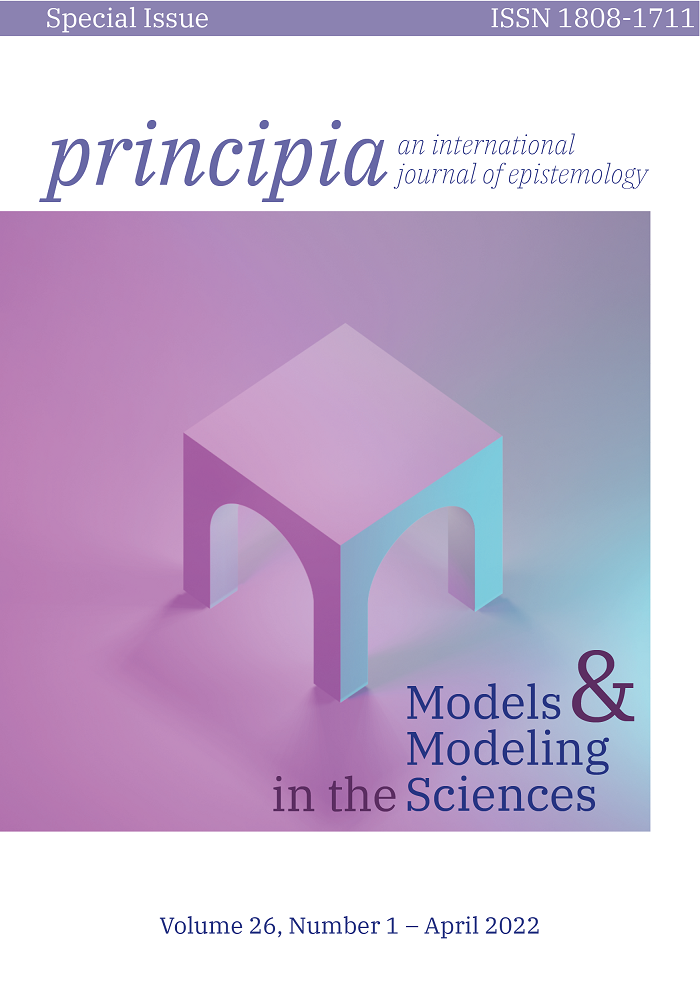Representing emergent phenomena
DOI:
https://doi.org/10.5007/1808-1711.2022.e84016Keywords:
scientific representation, DEKI account, cellular automata, emergent propertiesAbstract
Representational models are used in scientific practice to represent different phenomena. The purpose of this work is to examine the use of cellular automata (CA) to represent emergent phenomena, that is, phenomena with global aspects that cannot be predicted only from their local aspects, seeking to understand how the representation in this modeling process takes place. A suggested approach is the DEKI account developed by Roman Frigg and James Nguyen, in which the representation process involves four aspects: denotation of the target system by the model under an interpretation, exemplification of relevant properties in the model, formulation of a key that relates model properties with target properties and inputation of properties given by the key to the target. In this account, CA would represent the denoted target systems as complex systems that can be interpreted in local level and global level, so that emergent properties are exemplified in global level.
References
Bedau, M. 2002. Downward Causation and Autonomy in Weak Emergence. Principia 6(1): 5-50.
Elgin, C. 1983. With Reference to Reference. Indianapolis: Hackett.
Elgin, C. 2010. Telling Instances. In: R. Frigg & M. C. Hunter (ed.), Representation in Art and Science, p. 1-18. New York: Springer.
Frigg, R. & Nguyen, J. 2016. The Fiction View of Models Reloaded. The Monist 99(3): 225-242.
Frigg, R. & Nguyen, J. 2017. Models and Representation. In: L. Magnami & T. Bertolotti (ed.), Springer Handbook of Model-Based Science, p. 49-102. London and New York: Springer.
Frigg, R. & Nguyen, J. 2020. Modelling Nature: An Opinionated Introduction to Scientific Representation. Cham: Springer.
Ilachinski, A. 2001. Cellular Automata: A Discrete Universe. Singapore: World Scientific.
Callender, C. & Cohen J. 2006. There is no special problem about scientific representation. Theoria 21(1): 67-85.
Goodman, N. 1976. Languages of Art. 2nd Edition. Cambridge: Hackett.
Hughes, R. 1997. Models and representation. Philosophy of Science 64: S325-S336.
Kim, J. 1999. Making Sense of Emergence. Philosophical Studies 95(1/2): 3-36.
Ladyman, J.; Lambert, J.; Wiesner, K. 2013. What is a complex system? European Journal for Philosophy of Science 3(1): 33-67.
Libbrecht, K. 2005. The physics of snow crystals. Reports on Progress in Physics 68(4): 855-895.
Poundstone, W. 1985. The Recursive Universe: Cosmic Complexity and the Limits of Scientific Knowledge. Oxford: Oxford University Press.
Priest, G. 2011. Creating Non-Existentes. In: F. Lihoreau (ed.), Truth in Fiction, p. 107-118. Heusenstamm: Ontos Verlag.
Reiter, C. 2005. A local cellular model for snow crystal growth. Chaos, Solitons and Fractals 23(4): 1111-1119.
Schiff, J. 2008. Cellular Automata: A Discrete View of the World. Hoboken: John Wiley & Sons.
Suárez, M. 2003. Scientific Representation: Against Similarity and Isomorphism. International Studies in the Philosophy of Science 17(3): 225-244.
Symons, J. 2008. Computational Models for Emergent Properties. Minds and Machines 18(4): 475-491.
Thomasson, A. 1999. Fiction and Metaphysics. Cambridge: Cambridge University Press.
Toon, A. 2012. Models as Make-Believe: Imagination, Fiction and Scientific Representation. Basingstoke: Palgrave Macmillan.
Van Fraassen, B. 2008. Scientific Representation: Paradoxes of Perspective. Oxford: Oxford University Press.
Walton, K. 1990. Mimesis as Make-Believe: On the Foundations of Representational Arts. Cambridge: Harvard University Press.
Weisberg, M. 2012. Getting Serious about Similarity. Philosophy of Science 59(5): 785-794.
Weisberg, M. 2013. Simulation and Similarity: Using Models to Understand the World. Oxford: Oxford University Press.
Downloads
Published
Issue
Section
License
Copyright (c) 2022 William Ananias Vallerio Dias

This work is licensed under a Creative Commons Attribution-NonCommercial-NoDerivatives 4.0 International License.

Principia http://www.periodicos.ufsc.br/index.php/principia/index is licenced under a Creative Commons - Atribuição-Uso Não-Comercial-Não a obras derivadas 3.0 Unported.
Base available in www.periodicos.ufsc.br.



